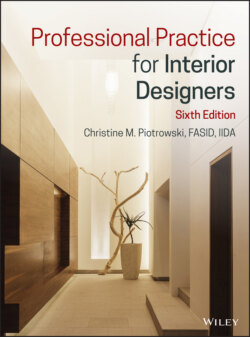Читать книгу Professional Practice for Interior Designers - Christine M. Piotrowski - Страница 131
CHAPTER 6 The Job Search
ОглавлениеThe job search is always a time‐consuming and stress‐producing period. Whether you are an individual about to graduate and are seeking your first job in the interior design industry, or a professional looking for a new challenge, the job search must be done with thought and planning. This job‐search process starts with the material that was covered in Chapter 5.
The interior design profession does ebb and flow with the economy. When times are good—meaning there is a generally robust economy—the job seeker may find that it takes longer to find a position, not a short time. This is because employers are probably not looking for anyone except very experienced designers. When the times are bad—meaning a slow or even recession‐hit economy—employers can find more possible employees since more people may be out of work due to layoffs. Yet this will likely mean a longer time to find a job.
Critical to the job search are strategies related to understanding how to use social media and online tactics to locate possible positions. Resumes, cover letters, and even portfolios have changed. Being prepared for the job interview is still vital and common courtesy has not changed in relation to follow‐up.
This chapter has been refocused to discuss online and social media tactics. However, the reader should also look for references noted in the general references and engage in online searches. Students will want to take advantage of services offered by campus placement offices as well.
After completing this chapter you should be able to:
Explain the importance of an organized job search.
Explain how an informational interview can be helpful to your overall job search.
Explain the purpose of key words and develop a list of at least 10 key words that could be included in a resume or cover letter.
Discuss the purpose of the resume.
Discuss how a resume prepared to be posted online will vary from one that will be paper (mailed).
Draft your resume with emphasis on a career objective or career summary.
Explain why an entry‐level designer should place educational achievements before work achievements on a resume.
Discuss why it is important to be careful about what kind of personal information is included in the resume.
Explain the purpose of a cover letter and list what it should contain.
Outline the types of items that are most often included in a portfolio.
Discuss the benefits and disadvantages of creating an electronic version of your portfolio.
Explain why a portfolio is never finished.
Discuss how you can tailor your portfolio to a job interview at a residential versus a commercial firm.
Draft a cover letter to a fictitious company indicating interest in joining their international division.
Draft a thank‐you note template that you could use after job interviews.
Discuss the necessity of preparing for a job interview, including the importance of doing “homework” about the interviewing firm.
Discuss why and how your apparel and other personal appearance issues can affect a job interview.
Explain the importance of projecting the right image for the job interview through good business etiquette.
Discuss how to handle an interview session when you are no longer interested in the position.
Explain diplomatic responses to illegal or improper questions posed during the job interview.
